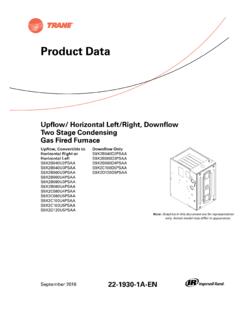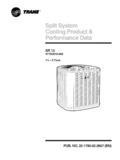Transcription of Evaporator Coil Cleaning and Condensate Drain …
1 American Standard 2007 1 Service Guide Evaporator Coil Cleaning and Condensate Drain Maintenance Guidelines ORDER No: UN-SVG001A-EN DATE: October 9, 2007 Introduction This document defines American Standard and trane s recommendations for Cleaning and maintaining Evaporator coils and Condensate lines in American Stan-dard and trane Residential Air-handlers, Furnace Coils and Packaged units. The intent of this paper is not to endorse any particular Cleaning products. The use of product names is only to provide clarification for the service person of the pH of some products. The Technician performing the service or maintenance is required to read the Material Safety Data Sheet (MSDS) for all coil- Cleaning products. The Service Technician is required to identify not only an individual product s pH; the Service Technician should also have a complete understanding of all safety and handling instructions for each Cleaning product used and the air conditioning equip-ment.
2 WARNING Hazardous Service Procedures! The maintenance and troubleshooting procedures recommended in this guide could result in exposure to electrical, mechanical or other poten-tial safety hazards. Always refer to the safety warnings provided throughout this guide concerning these procedures. When possible, dis-connect all electrical power including remote disconnect and discharge all energy storing devices such as capacitors before servicing. Follow proper lockout/tagout procedures to ensure the power can not be inad-vertently energized. When necessary to work with live electrical compo-nents, have a qualified licensed electrician or other individual who has been trained in handling live electrical components perform these tasks. Failure to follow all of the recommended safety warnings provided, could result in death or serious injury. NOTICE: Warnings and Cautions appear at appropriate sections throughout this bulletin. Read these carefully.
3 WARNING Indicates a potentially hazardous situation which, if not avoided, could result in death or serious injury. CAUTION Indicates a potentially hazardous situation which, if not avoided, may result in minor or moderate injury. It may also be used to alert against unsafe practices. CAUTION Indicates a situation that may result in equipment or property-damage-only accidents. UN-SVG001A-EN 2 Discussion Coil and Cabinet Cleaning 1. American Standard s and trane s recommendation for coil Cleaning is to use neutral-pH cleaners. This is required to avoid the use of strong acids and strong base clean-ers. Thus, cleaners with pH range from 5 to 11 are suitable for coil Cleaning . This range includes such over-the-counter cleaners as Simple Green All Purpose Cleaner, or HVAC coil cleaners like Nu-Calgon Evap Pow'r . 2. Strong acidic cleaners (pH of 5 or less) that contain hydrochloric, sulfuric, nitric, or acetic acid are not recommended for use on copper-tube, aluminum fin coils or on aluminum tube, aluminum fin coils.
4 Presence of these acids will result in rapid corro-sion of the metals. 3. Strong alkali (base) cleaners (pH of 11 or more) containing sodium, potassium, or ammonium hydroxide are not recommended as they will aggressively corrode alumi-num tubes and fins. Strong ammonium hydroxide cleaners will also cause stress cor-rosion cracking of copper tubes. 4. American Standard and trane recommend completely rinsing all cleaner from the coil - including cleaners identified as No-Rinse cleaners. Residual cleaners may decom-pose over time producing low molecular weigh, organic acids that lead to formicary corrosion. 5. We agree with many of our dealers that only removing an Evaporator coil is the best way to effectively clean a coil that is heavily contaminated. This is accomplished by removing it from the cabinet and using a strong water stream such as from a garden hose. Lightly spraying cleaners on a coil with a spray bottle and rinsing with water from a spray bottle does not effectively clean it and certainly does not effectively rinse the cleaner from the coil.
5 6. A coil operating for many months without an air filter will likely require removal to achieve proper Cleaning . Visual inspection of the indoor equipment is the ideal deter-mining factor if a coil is contaminated enough to warrant coil removal for Cleaning . Evi-dence of this would be a heavy mat of fiber and hair on the inlet side of the coil and discoloration of the fins on both sides of the coil. Another, easily detectable symptom is a dirty blower wheel. A dirty blower wheel indicates a need for coil inspection as this means contaminants have been getting past the filter at some time or the unit has been operated without a filter. Air handler or Packaged Unit: Remove the Evaporator coil and fan assembly for proper Cleaning if there is also contamination on the inside of the cabinet and/or contamination other than normal household dirt, lint (etc.) on the coil. Proper clean-ing of the cabinet insulation, wiring, and other components are required as well.
6 Wipe these surfaces down with the same neutral or moderate pH cleaners de-scribed in item number 1 above Cased Coil: Remove the Evaporator coil for proper Cleaning if there is also contami-nation on the inside of the cabinet and/or contamination other than normal house-hold dirt, lint (etc.) on the coil. Proper Cleaning of the cabinet insulation and other components are required as well. Wipe these surfaces down with the same neutral or moderate pH cleaners described in item number 1 above. If the coil is to be removed we require adherence to all safety warnings and cautions that appear in the literature shipped with the equipment and affixed to the units itself. Recom-mended refrigerant handling precautions and practices must be followed as well. Routine maintenance Cleaning should not be done using chemical cleaners unless the coil is re-moved. In place Cleaning can be done with the use of a vacuum cleaner using an uphol-stery brush attachment or by other brushes that will not damage or distort the coil fins.
7 WARNING Personal Protective Equipment (PPE) Required! Always refer to appropriate MSDS and OSHA guidelines when handling fluorocarbon refrigerants. Use proper breathing, eye, and body protec-tion during the handling of fluorocarbon refrigerants. Failure to follow proper handling guidelines could result in death or serious injury. UN-SVG001A-EN 3 Conclusion Coil and Cabinet Cleaning Cleaning the coil, filter, blower wheel and cabinet interior is an integral part of system per-formance and reliability. This paper does not cover all possible Evaporator coil- Cleaning situations; however, it has pointed out the importance of regular air filter changes. The Installing Dealer should review the Home Owners Guide with the end-user and reinforce the importance of regular air filter changes. For further clarification, the Servicing Dealer should consult with the supplier of the Cleaning products for directions on how to achieve a pH of 5 to 11.
8 Your local American Standard or trane Field Service Representative can provide instruction on Evaporator coil removal, servicing of the refrigeration system and reinstallation of coils. Discussion Condensate Management and Maintenance Condensate management and maintenance is a key to the proper operation of the A/C sys-tem. Moisture removed by the A/C system contains pollutants (chemicals, smoke, etc.) that are in the air. These elements, as well as the moisture, must be removed from the Drain pan and the Condensate lines to ensure comfort and coil reliability. Traps must be installed within 4 feet of the air handler or cooling coil per the installer guide. (See Figure 1) Secondary Drain lines do not need to be trapped. Additionally, the secondary Drain connection should not be used to connect a float switch or emergency shutoff switch. If local codes require the secondary Drain line connection to be used for a float switch or emergency shutoff switch, the switch should be positioned at a level below the primary Drain outlet.
9 This will prevent the level of Condensate in the coil Drain pan from rising above the level of the weep hole (in some Drain pans) and overflowing. American Standard / trane recommends that the secondary Drain terminate at a con-spicuous location where the occupants can easily see any Condensate draining from the secondary line and notify their servicing contractor. All primary Drain lines should be insulated if there is a possibility of the Condensate line reaching the dew point of the surrounding air. The trap is an integral part of Condensate removal that provides a positive seal and is nec-essary for proper Condensate removal. The close coupling in the linear piece of the trap en-sures a complete cleansing of the trap on most cooling cycles and, therefore, will reduce the chance of a clogged trap resulting in Condensate overflow. The trap must be a minimum of 2 inches in depth The linear piece of the trap (the bottom horizontal piece) should be as close coupled as possible The trap must be within 4 feet of the unit The guidelines above are shown in figure 1.
10 The following information covers Evaporator Condensate management system installation and maintenance guidelines for under slab drains (Figure 2 and 3) as well as recommen-dations for Cleaning all Condensate drains The outlet side of the trap must be vented to atmosphere to prevent the effects of double trapping. The stand pipe must be higher than the primary Drain connection UN-SVG001A-EN 4 Typical Air Handler Condensate Recommendation Figure 2 Horizontal run of trap should be as close coupled as possible UN-SVG001A-EN 5 Figure 3 Typical Furnace and Coil Condensate Recommendation Preventative maintenance of the Condensate line is also recommended at least once a year, preferably before the cooling season. American Standard and trane recommend the use of only fresh water to flush the line.




